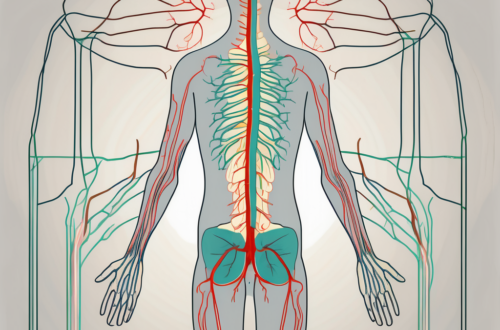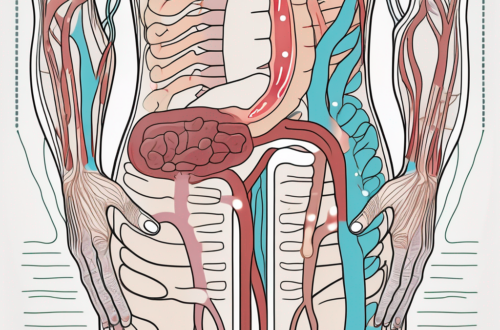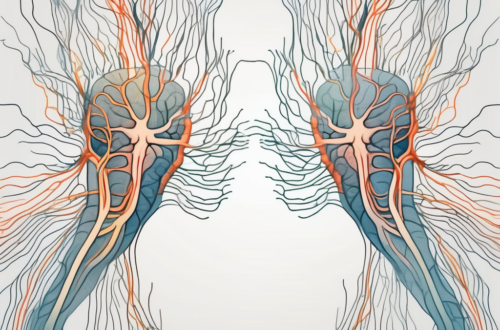Autonomic reflexes play a critical role in maintaining homeostasis within the human body. These reflexes are responsible for regulating involuntary actions, such as heart rate, digestion, and respiratory functions. While both the sympathetic and parasympathetic divisions of the autonomic nervous system contribute to these reflexes, recent research has shed light on the dominant role of parasympathetic nerve fibers in their regulation. Understanding this dominance is crucial for unraveling the complexities of autonomic reflexes and their implications for overall health and wellbeing.
The Basics of Autonomic Reflexes
Before delving into the specific role of parasympathetic nerve fibers, it is essential to define and understand the nature of autonomic reflexes. Autonomic reflexes are automatic responses, controlled by the autonomic nervous system, that regulate bodily functions without conscious thought or effort. These reflexes ensure our organs and systems operate optimally, responding to changes in our environment or physiological needs. They allow our bodies to maintain balance and adapt to various situations, keeping us alive and functioning.
Autonomic reflexes can be broadly defined as automatic physiological responses to stimuli. They involve the activation of both sympathetic and parasympathetic nerve fibers, which work in tandem to regulate bodily functions. These reflexes generally occur without our conscious awareness, as our autonomic nervous system seamlessly orchestrates their execution. This intricate system enables our bodies to respond to stimuli, such as changes in temperature or the need for increased blood flow to certain organs, without conscious thought.
One example of an autonomic reflex is the pupillary light reflex. When light is shone into the eye, the autonomic nervous system immediately responds by constricting the pupil to reduce the amount of light entering the eye. This reflex occurs automatically and rapidly, ensuring that our eyes are protected from excessive light and maintaining optimal vision.
Another important autonomic reflex is the cardiovascular reflex. When blood pressure drops, the autonomic nervous system activates the sympathetic division, which increases heart rate and constricts blood vessels to raise blood pressure. Conversely, when blood pressure is too high, the parasympathetic division is activated, causing a decrease in heart rate and dilation of blood vessels to lower blood pressure. These reflexes work together to maintain blood pressure within a healthy range, ensuring proper blood flow to all organs and tissues.
The Role of the Nervous System in Autonomic Reflexes
The autonomic nervous system, consisting of the sympathetic and parasympathetic divisions, plays a pivotal role in coordinating autonomic reflexes. The sympathetic division prepares the body for action, commonly known as the “fight or flight” response, while the parasympathetic division promotes rest, relaxation, and restoration. Together, these divisions ensure a delicate balance in the regulation of bodily functions.
When faced with a perceived threat or danger, the sympathetic division of the autonomic nervous system activates. This response triggers the release of stress hormones, such as adrenaline, which increase heart rate, dilate airways, and redirect blood flow to the muscles. These physiological changes prepare the body to either confront the threat or flee from it, ensuring survival in potentially dangerous situations.
On the other hand, the parasympathetic division of the autonomic nervous system promotes rest and restoration. It is responsible for conserving energy, slowing heart rate, and promoting digestion. When we are in a relaxed state, the parasympathetic division dominates, allowing our bodies to recover, repair, and maintain homeostasis.
Autonomic reflexes are crucial for our overall well-being and survival. Without these automatic responses, our bodies would struggle to adapt to changes in our environment and maintain the necessary balance for optimal functioning. Understanding the basics of autonomic reflexes and the role of the nervous system in coordinating them provides insight into the intricate mechanisms that keep us alive and thriving.
An Overview of Parasympathetic Nerve Fibers
Now, let’s shift our focus to the parasympathetic division of the autonomic nervous system and explore the various aspects of parasympathetic nerve fibers.
The parasympathetic division of the autonomic nervous system plays a crucial role in maintaining homeostasis within the body. It works in opposition to the sympathetic division, which is responsible for the “fight or flight” response. The parasympathetic system, on the other hand, promotes rest, relaxation, and restoration.
Parasympathetic nerve fibers are an essential component of this system. They release the neurotransmitter acetylcholine, which acts as a chemical messenger to transmit signals between nerve cells. This neurotransmitter binds to specific receptors on target cells, initiating a cascade of events that ultimately lead to the desired physiological response.
The Function of Parasympathetic Nerve Fibers
Parasympathetic nerve fibers are primarily responsible for promoting rest, relaxation, and restoration within the body. When activated, these fibers slow down heart rate, constrict blood vessels, stimulate digestion, and promote other functions that help the body relax and recuperate.
One of the key functions of parasympathetic nerve fibers is to regulate the heart rate. When the body is at rest, these fibers release acetylcholine, which binds to receptors on the heart muscle cells. This binding slows down the electrical signals that control heart rate, resulting in a decrease in heart rate. This allows the heart to pump blood more efficiently, conserving energy and promoting overall relaxation.
In addition to regulating heart rate, parasympathetic nerve fibers also play a crucial role in promoting digestion. When we eat, these fibers release acetylcholine, which stimulates the release of digestive enzymes and increases blood flow to the digestive organs. This enhances the process of breaking down food and absorbing nutrients, ensuring optimal digestion and nutrient absorption.
The Structure of Parasympathetic Nerve Fibers
Parasympathetic nerve fibers are intricately woven throughout the body, branching out from the cranial nerves and the sacral spinal cord. They form a complex network that extends to various organs, including the heart, lungs, digestive system, and reproductive organs.
The structure of parasympathetic nerve fibers allows for targeted regulation of specific bodily functions, enabling the body to respond with precision and efficiency. For example, the cranial nerves, such as the vagus nerve, carry parasympathetic fibers that innervate organs in the head, neck, and thoracic cavity. These fibers control functions such as salivation, tear production, and constriction of the bronchioles in the lungs.
Similarly, the sacral spinal cord gives rise to parasympathetic fibers that innervate the pelvic organs, including the bladder, reproductive organs, and lower gastrointestinal tract. These fibers control functions such as urination, sexual arousal, and defecation.
Overall, the complex network of parasympathetic nerve fibers allows for precise control and coordination of various bodily functions, ensuring optimal rest, relaxation, and restoration.
The Interaction between Parasympathetic Nerve Fibers and Autonomic Reflexes
Now that we have established the functions and structure of parasympathetic nerve fibers, it is crucial to understand how they interact with autonomic reflexes.
The intricate relationship between parasympathetic nerve fibers and autonomic reflexes is essential for maintaining the overall balance and homeostasis of the body. These nerve fibers play a significant role in autonomic reflexes by regulating the delicate equilibrium between sympathetic and parasympathetic activity.
The activation of parasympathetic nerve fibers opposes the “fight or flight” response initiated by the sympathetic division of the autonomic nervous system. This opposition allows the body to rest and recover from periods of heightened activity or stress. It ensures that bodily functions return to a state of equilibrium, promoting overall well-being.
The Influence of Parasympathetic Nerve Fibers on Autonomic Reflexes
Parasympathetic nerve fibers exert a profound influence on autonomic reflexes. Their activation helps to restore balance and counteract the effects of sympathetic activity. By dampening the sympathetic response, parasympathetic nerve fibers allow the body to conserve energy, promote digestion, and facilitate other essential functions.
One example of the influence of parasympathetic nerve fibers on autonomic reflexes is the regulation of heart rate. When the body is at rest, parasympathetic activity dominates, slowing down the heart rate. This decrease in heart rate is crucial for conserving energy and maintaining a relaxed state. On the other hand, during moments of stress or physical exertion, sympathetic activity increases, leading to an accelerated heart rate. The interplay between parasympathetic and sympathetic nerve fibers ensures that the heart rate adjusts accordingly to meet the body’s demands.
The Mechanism of Parasympathetic Nerve Fibers in Autonomic Reflexes
Parasympathetic nerve fibers exert their control over autonomic reflexes through a finely tuned mechanism. This mechanism involves a complex interplay between sensory receptors, the brain, spinal cord, and the release of specific neurotransmitters.
When certain sensory receptors detect changes in the body’s internal or external environment, they send signals to the brain and spinal cord. These signals are then processed and interpreted, leading to a response from the parasympathetic nervous system. Upon receiving the signals, parasympathetic nerve fibers release acetylcholine, a neurotransmitter that plays a crucial role in the regulation of autonomic reflexes.
Acetylcholine binds to specific receptors located on target cells, initiating a cascading series of events. This binding triggers a chain reaction that ultimately leads to a reduction in sympathetic activity and an increase in parasympathetic activity. The result is a shift towards a more relaxed state, promoting rest, digestion, and other essential bodily functions.
The mechanism of parasympathetic nerve fibers in autonomic reflexes is a delicate and intricate process that ensures the body’s overall well-being. This finely tuned control system allows for the appropriate response to various stimuli, maintaining a state of balance and harmony within the body.
The Dominance of Parasympathetic Nerve Fibers in Autonomic Reflexes
It is evident that parasympathetic nerve fibers hold a dominant role in the regulation of autonomic reflexes. This dominance becomes more pronounced as we explore the impact of parasympathetic activity on overall body functions.
Exploring the Dominance of Parasympathetic Nerve Fibers
Research suggests that the parasympathetic division of the autonomic nervous system is more active during periods of rest and relaxation, making it the dominant force in maintaining homeostasis. The influence of parasympathetic nerve fibers ensures that our bodies recover, heal, and regenerate effectively. Disruptions in parasympathetic activity can lead to imbalances and dysfunction within the autonomic reflexes, potentially impacting our overall health.
When we engage in activities that promote rest and relaxation, such as meditation or deep breathing exercises, the parasympathetic nervous system becomes more active. This activation triggers a cascade of physiological responses that promote a state of calmness and balance within the body. The parasympathetic division slows down heart rate, constricts blood vessels, and stimulates digestion, all of which contribute to a sense of tranquility and well-being.
Furthermore, the dominance of parasympathetic nerve fibers is not limited to restful periods alone. Even during wakefulness, the parasympathetic division continues to play a crucial role in maintaining bodily functions. For example, it helps regulate blood pressure by releasing acetylcholine, a neurotransmitter that causes blood vessels to dilate and lowers blood pressure. This mechanism ensures that our cardiovascular system remains in a state of equilibrium, preventing sudden spikes or drops in blood pressure that could be detrimental to our health.
The Impact of Dominant Parasympathetic Nerve Fibers on Body Functions
Proper functioning of the parasympathetic division is crucial for supporting various body functions, including digestion, immune response, and sleep regulation. It contributes to the efficient breakdown and absorption of nutrients during digestion, enhancing our body’s ability to extract essential vitamins, minerals, and energy from the food we consume.
In addition to digestion, the parasympathetic division also plays a vital role in our immune response. It stimulates the production of antibodies and activates immune cells, such as lymphocytes, to defend against pathogens and foreign invaders. This ensures that our body’s defense mechanisms are functioning optimally, protecting us from infections and diseases.
Moreover, the dominance of parasympathetic nerve fibers extends to the regulation of sleep. During the night, when we enter the restorative phase of sleep, the parasympathetic division becomes more active. It promotes the release of melatonin, a hormone that regulates our sleep-wake cycle, ensuring that we experience deep and restful sleep. This enables our body to repair and rejuvenate itself, preparing us for the challenges of the following day.
In conclusion, the dominance of parasympathetic nerve fibers in autonomic reflexes is crucial for maintaining homeostasis and supporting various body functions. Whether during periods of rest or wakefulness, the parasympathetic division plays a vital role in promoting overall health and well-being. Understanding the intricate workings of this dominant force within our autonomic nervous system allows us to appreciate the importance of rest, relaxation, and self-care in maintaining a balanced and thriving body.
Future Research Directions in Parasympathetic Nerve Fibers and Autonomic Reflexes
As the understanding of parasympathetic nerve fibers and their dominant role in autonomic reflexes continues to evolve, several promising research directions have emerged.
The intricate network of parasympathetic nerve fibers within the autonomic nervous system holds great potential for further exploration and discovery. By delving deeper into the functions, structure, and interactions of these nerve fibers, researchers can gain valuable insights into the regulation of bodily functions and potential therapeutic interventions.
Potential Applications of Understanding Parasympathetic Nerve Fibers Dominance
Exploring the implications of parasympathetic nerve fibers dominance may pave the way for the development of innovative therapeutic interventions. By targeting and modulating parasympathetic activity, researchers can potentially address various health conditions, including cardiovascular diseases, gastrointestinal disorders, and sleep disturbances.
For instance, studies have shown that parasympathetic nerve fibers play a crucial role in regulating heart rate and blood pressure. Understanding the mechanisms by which these nerve fibers influence cardiovascular function could lead to the development of novel treatments for conditions such as hypertension and arrhythmias.
Furthermore, the parasympathetic nervous system is intricately involved in the regulation of digestion and gastrointestinal motility. By gaining a deeper understanding of the interactions between parasympathetic nerve fibers and the digestive system, researchers may be able to develop targeted therapies for gastrointestinal disorders such as irritable bowel syndrome and gastroparesis.
Sleep disturbances, such as insomnia and sleep apnea, are also influenced by the activity of parasympathetic nerve fibers. Investigating the role of these nerve fibers in sleep regulation could potentially lead to the development of new treatments for sleep disorders, improving the quality of life for millions of individuals.
However, it is crucial to consult with healthcare professionals and experts in the field to determine the safest and most effective approaches for individual cases. Each person’s health condition is unique, and personalized treatment plans should be developed based on comprehensive medical assessments.
The Future of Autonomic Reflexes Research
The field of autonomic reflexes research is constantly evolving, with numerous promising avenues for exploration. Further investigations into the intricate interactions between parasympathetic and sympathetic nerve fibers may unlock new insights into the regulation of bodily functions and potential therapeutic interventions.
One area of interest is the role of parasympathetic nerve fibers in stress responses. It is well-known that the sympathetic nervous system is responsible for the fight-or-flight response, but recent studies have highlighted the involvement of parasympathetic activity in stress modulation. Understanding the interplay between these two branches of the autonomic nervous system could lead to the development of more comprehensive stress management strategies.
Additionally, the impact of parasympathetic nerve fibers on immune system regulation is an emerging area of research. The immune system is intricately connected to the autonomic nervous system, and understanding how parasympathetic activity influences immune responses could have profound implications for the treatment of autoimmune diseases and inflammatory conditions.
Continued collaboration between researchers and medical professionals will play a vital role in advancing our understanding of autonomic reflexes and their implications for human health. By combining expertise from various disciplines, such as neurology, cardiology, gastroenterology, and sleep medicine, researchers can work towards a comprehensive understanding of the complex interactions within the autonomic nervous system.
In conclusion, the dominant role of parasympathetic nerve fibers in autonomic reflexes cannot be underestimated. Understanding this dominance provides a crucial foundation for comprehending the intricacies of our bodily functions and their regulation. As we delve deeper into the functions, structure, and interactions of parasympathetic nerve fibers, we gain insights that may ultimately contribute to the development of novel therapeutic approaches aimed at optimizing our health and wellbeing.
It is important to acknowledge the significant role of parasympathetic nerve fibers while consulting with healthcare professionals for comprehensive medical advice. By working together, researchers, clinicians, and patients can pave the way for advancements in the understanding and treatment of various health conditions influenced by the autonomic nervous system.





